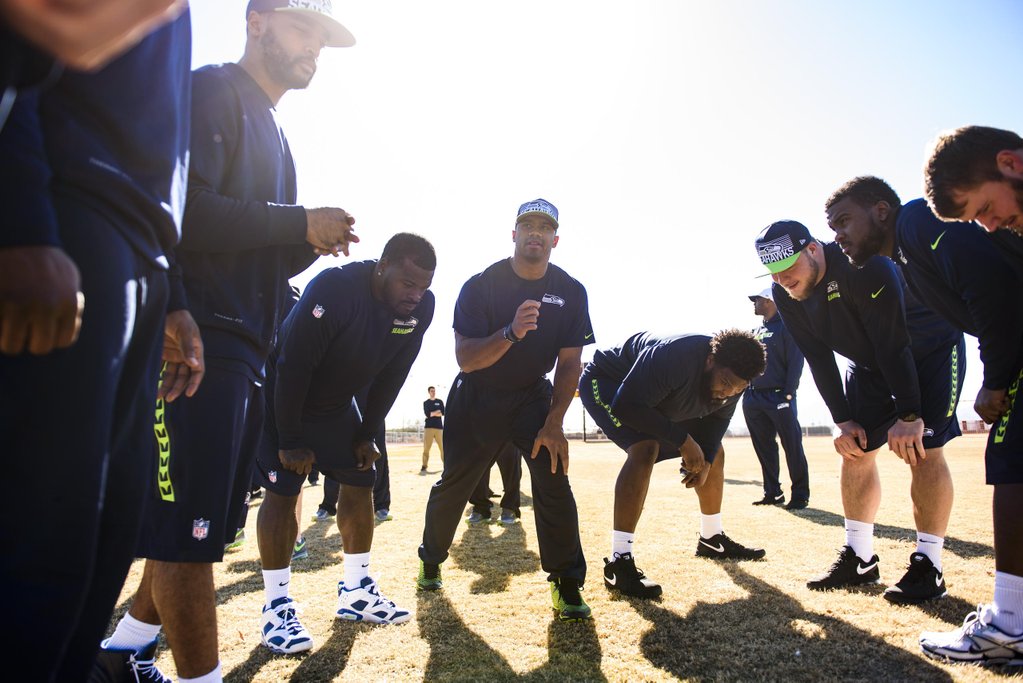Despite being among the most anonymous and mundane parts of football team, the offensive line gets a ton of attention. Seahawks fan, in particular, fixate on the line after witnessing one of the most dominating left sides in history take them all the way to the Super Bowl.
Many teams build up a line using the classic formula of a dominating left tackle (usually 6’5″+ and athletic), bulky guards over 320 lbs and a tenacious line leader at center. Alex Gibbs flew in the face of convention as he built one of the lightest and least intimidating lines in the NFL. He rose to fame when those Denver Broncos lines led to multiple Super Bowls and countless no-name 1,000+ yard rushers.
Gibbs accomplished these feats by valuing athleticism over bulk, and smarts over talent. His lines were known for giving defensive lineman fits with leg whips, cut blocks and flawless teamwork. When I look at the current Seahawks offensive line, I can’t help but wonder how it will work to mesh Gibbs’ philosophies with lineman inherited from past regimes, built largely under old-school philosophies.
My impression is that the Seahawks line is too bulky to be effective at the cut blocking that Gibbs loves. I can’t help but wonder how much the Hawks preferred Trent Williams to Russell Okung because of his drool-worthy athleticism for a tackle. Spencer seems far heavier than the classic Gibbs centers like Tom Nalen. Locklear is athletic, but quite big as well. Like I often do, I decided to go quantitative on your asses, and see how the Hawks line stacked up in height, weight and age to previous notable Gibbs’ lines.
Here’s what I found:
I picked two Broncos lines. The first, 1997, was the first of their two Super Bowl wins. The same line returned for the 1998 season. The second, 1999, was a sample of a line in transition (like the Seahawks), which I thought would give me some insight into how Gibbs likes to build a line when acquiring new players. A few things jump out. First, the championship line was old, with only one player under the age of 31. Second, they were light, weighing in at an average of only 290 lbs. They were lanky, though, with an average height of 76.5 inches (6’4.5″). When Gibbs had to replace two key members on his line, he did so with young players, not veterans. He also made the line *lighter*, dropping the average weight to a tight-endish 286.5lbs. Now, we should take into account that the average weight of NFL lineman has likely increased in the 11 years since the 1999 Broncos line, but I am old enough to remember they were tiny even by 1999 standards.
The Texans 2008 line cleared the path for Steve Slatton to run for 1,282 yards and 4.8 YPC. That group looks nothing like the Broncos lines of old. Every player is over 300 lbs, and the average age is under 26. It’s worth noting that Gibbs approved bringing over the heaviest of those Texans lineman, Chester Pitts, to play for the Hawks. That should at least tell us that Gibbs doesn’t think being light is a prerequisite to being effective in his scheme.
The Hawks line doesn’t look so bulky, too old, or too young by these standards. Now, I think the roster showing Russell Okung weighing the same 310 as Sean Locklear is suspect, but I’d bet the other weights for the other team’s lineman are equally suspect. It wouldn’t surprise me at all if the Broncos lineman were even lighter than what’s shown online.
This information isn’t enough for us to draw any conclusions, but it does help me feel a little less skeptical that our personnel will match up with the new scheme, especially given the Texans makeup.
